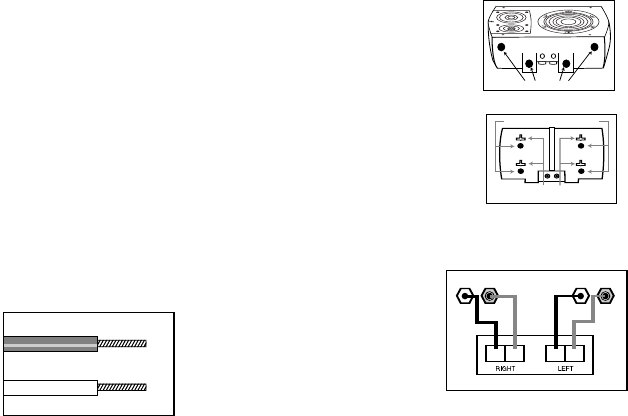
If there is no sound from any of the
speakers:
• Check that receiver/amplifier is
on and that a source is playing.
• Review proper operation of your
receiver/amplifier.
• Make sure all wires are con-
nected. Make sure none of the
speaker wires are frayed, cut or
punctured, or touching each other.
If the system plays at low volumes
but shuts off as volume is
increased:
• Check all wires and connections
between receiver/amplifier and
speakers.
• Make sure all wires are con
-
nected. Make sure none of the
speaker wires are frayed, cut or
punctured, or touching each other
.
• If more than one pair of main
speakers is being used, check the
minimum impedance requirements
of your receiver/amplifier.
If there is no sound coming from
one speaker:
• Check the “Balance” control on
your receiver/amplifier.
• Check all wires and connections
between receiver/amplifier and
speakers. Make sure no wires are
touching other wires or terminals
and creating a short circuit.
• Make sure all wires are con-
nected. Make sure none of the
speaker wires are frayed, cut or
punctured.
• In Dolby
®
Digital or DTS
®
modes,
make sure that the receiver/
processor is configured so that the
speaker in question is enabled.
• Turn off all electronics and switch
the speaker in question with one of
the other speakers that is working
correctly. Turn everything back on,
and determine whether the prob-
lem has followed the speaker, or
has remained in the same channel.
If the problem is in the same chan-
nel, the source of the problem is
most likely with your receiver or
amplifier
, and
you should consult the
owner’s manual for that product for
further information.
If the problem
has followed the speaker, consult
your dealer for further assistance
or
, if that is not possible, visit
www.jbl.com for further infor-
mation.
CONNECTION TIPS
SPEAKER CONNECTIONS
5
–6 ft.
Speakers and electronics terminals
have corresponding (+) and (–) ter-
minals. It is important to connect
both speakers identically: (+) on the
speaker to (+) on the amplifier and
(–) on the speaker to (–) on the
amplifier. Wiring “out of phase”
results in thin sound, weak bass
and a poor stereo image. With the
advent of multichannel surround
TROUBLESHOOTING
– +– +
– +
Speaker Outputs
L
EFT
RIGHT
– +
Installation of Self-Adhesive
R
ubber Pads:
I
f the speaker is to
be placed on a surface (such as
a
table top or shelf) rather than
wall-mounted, the enclosed self-
adhesive rubber pads are to be
a
ttached to the bottom of the
speaker cabinet in their desig-
n
ated recessed locations. If the
speaker is to be wall-mounted,
t
hen the four self-adhesive rubber
p
ads should be attached to the
back of the speaker, as shown
i
n the bottom right diagram.
W
hen angle-mounting the P36AW,
only two of the rubber pads are
required, and they need to be
i
nstalled on the back of the loud-
s
peaker, near the lower edge, so
that they are located between the
b
ack of the speaker and the
m
ounting surface. Please see the
e
nclosed installation template for
more details.
NOTE: The threaded inserts on the
bottom of the speakers are to be
u
sed only with JBL accessories
that have been developed specifi-
c
ally for the P36AW and that may
become available at a future date.
Do not attempt to install bolts or
any non-JBL brackets or acces-
sories to these threads, as this
might damage the speaker and
d
islodge the insert.
PADS GO HERE
sound systems, connecting all of
the speakers in your system with
the correct polarity remains
equally important in order to pre-
serve the proper ambience and
directionality of the program
material.
To use the binding-post speaker
terminals, unscrew the collar until
the pass-through hole in the cen-
ter post is visible under the collar.
Insert the bare end of the wire
through this hole; then screw the
collar down until the connection
is tight.
The hole in the center of each col-
lar is intended for use with banana-
type connectors.
To comply with
KEYHOLES FOR
MOUNTING HARDWARE
PLACE RUBBER PADS HERE
For wall-mounting
For tabletop or shelf placement
European CE certification, these
holes are blocked with plastic
inserts at the point of manufacture.
Use of banana-type connectors
requires the removal of the inserts.
Do not remove these inserts if
you are using the product in an
area covered by European CE
certification.
Performance P36AW OM 10/6/05 2:41 PM Page 3






